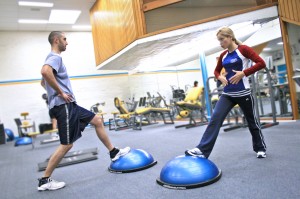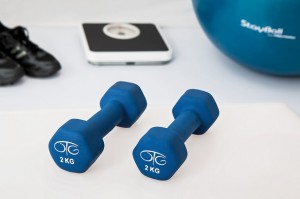Today our workout is going to focus on strength, stability and balance. The only piece of equipment you will need is a Bosu Ball, as that is what we will use for each of our exercises today. Although this is a full-body workout, you will really be targeting the core in order to stabilize and balance the ball during this workout. Note that any of these exercises can be modified by performing them without the bosu ball. This workout can be done in home, at the gym, or outside at your favorite spot in nature.
As with many of the other workouts we have done, this is a circuit workout. You will perform each exercise down the list once, back-to-back, with little to no rest in between. Once you finish the entire circuit you will rest between 30-60 seconds, and will repeat the same routine again for a total of 3 times! If you are a beginner, start by doing the circuit only once and work your way up to three sets. Remember that these routines can be done and modified by anyone, regardless of fitness level. As always, I will post descriptions of each exercise below. I will also paste some links to YouTube videos showing each exercise (note that these are not my personal videos). Here we go:
30 Second Bosu Mountain Climbers
10 Bosu Push-ups
8 Bosu Burpees
10 Bosu Balancing Squats
15 Bosu Bridges
1 Minute Bosu Plank Hold
Bosu Mountain Climbers – Start in a full (straight-arm) plank with the round side of the bosu ball down on the ground and yours hands on tops of the flat side. With the shoulders staying directly over the hands, begin by bringing one knee in towards the chest, then switch legs. Continue doing this at a fast pace for 30 seconds. Use your abs to stabilize the ball.
Bosu Push-ups – Again you will begin with the round side of the ball down and your hands up on the flat part. With shoulders directly above the hands, perform a push-up just as if you were performing one on the ground. Really squeeze and tighten those abs to keep the ball steady. You may drop down to your knees if this is too challenging. Perform 10 repetitions.
Bosu Burpees – These are just like regular burpees (or should I say death!) only you will be holding the bosu ball the whole way through. Start in a standing position holding the flat side of the bosu ball overhead. Lower it to the floor by putting the round side down. Continuing to grip the flat side, jump your legs straight out behind you into a plank position, then back in and come back to a standing position bringing to bosu ball overheard once again. Complete 8 of these.
Bosu Balancing Squats – Begin with the bosu ball on the ground, round side down. Step your feet onto the flat side of the ball (you may need a wall to help you get onto the ball). Once you find your balance, begin squatting by keeping the weight in your heels and dropping down as if you were sitting in a chair. Go down as far as possible. Note that the ball will shake, this is OK and normal. Tighten your core the entire time for balance and stability. Continue on doing this 10 times.
Bosu Bridges – This time we are going to have the flat side of the ball down on the ground (yayy!)…don’t get too excited yet =). Lay down on your back with your feet on top of the bosu ball, legs bent. Use the heels of your feet to lift your hips up off the ground, squeexing the glutes at the top, then slowely and steadily lower back down. Repeat this 15 times.
Bosu Plank Hold – As if we haven’t worked our abs enough during this workout, we are going to end with a 1 minute plank hold. Perform a full plank with the round side of the ball down and your hands on the flat part and hold for 1 minute.
YouTube Videos (in order by exercise)



 force in quicker time periods. Strong legs help with that extra push, a strong core aids in balance and stability, and upper body strength helps maintain that speed. This was proven in a study done that tested the correlation between explosive strength training and 5-km running time in endurance athletes. In the experiment, 18 endurance athletes trained for 9 weeks. While both groups kept the same training volume, 10 of these subjects trained with simultaneous explosive strength training and endurance training, while the other 8 subjects participated in endurance training only. 5K time was improved in the well-trained endurance athletes who participated in simultaneous explosive strength training and endurance training due to improved neuromuscular characteristics.
force in quicker time periods. Strong legs help with that extra push, a strong core aids in balance and stability, and upper body strength helps maintain that speed. This was proven in a study done that tested the correlation between explosive strength training and 5-km running time in endurance athletes. In the experiment, 18 endurance athletes trained for 9 weeks. While both groups kept the same training volume, 10 of these subjects trained with simultaneous explosive strength training and endurance training, while the other 8 subjects participated in endurance training only. 5K time was improved in the well-trained endurance athletes who participated in simultaneous explosive strength training and endurance training due to improved neuromuscular characteristics. a great way to burn body fat. Now, cardio certainly does burn a significant amount of calories, however, those calories stop burning off as soon as that hour or so of cardio is finished. With strength training, lean muscle mass is built, which aides in the body not only burning calories during periods of exercise, but also while that person is at rest! Clearly, a body with more lean muscle and less fat is going to be lighter, aiding in speed and also in better body composition.
a great way to burn body fat. Now, cardio certainly does burn a significant amount of calories, however, those calories stop burning off as soon as that hour or so of cardio is finished. With strength training, lean muscle mass is built, which aides in the body not only burning calories during periods of exercise, but also while that person is at rest! Clearly, a body with more lean muscle and less fat is going to be lighter, aiding in speed and also in better body composition.